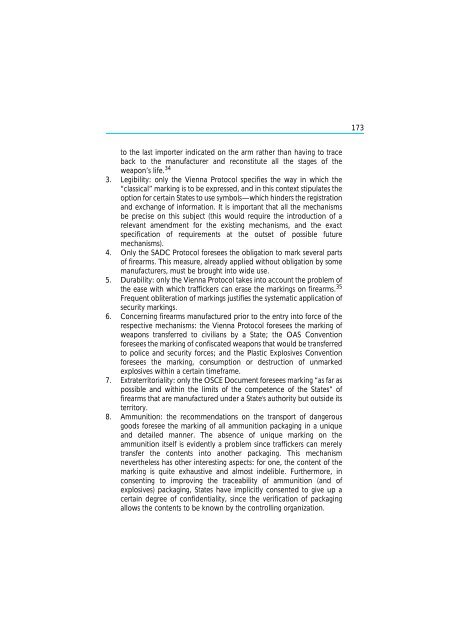The Scope and Implications of a Tracing Mechanism for Small Arms ...
The Scope and Implications of a Tracing Mechanism for Small Arms ...
The Scope and Implications of a Tracing Mechanism for Small Arms ...
You also want an ePaper? Increase the reach of your titles
YUMPU automatically turns print PDFs into web optimized ePapers that Google loves.
to the last importer indicated on the arm rather than having to trace<br />
back to the manufacturer <strong>and</strong> reconstitute all the stages <strong>of</strong> the<br />
weapon’s life. 34<br />
3. Legibility: only the Vienna Protocol specifies the way in which the<br />
“classical” marking is to be expressed, <strong>and</strong> in this context stipulates the<br />
option <strong>for</strong> certain States to use symbols—which hinders the registration<br />
<strong>and</strong> exchange <strong>of</strong> in<strong>for</strong>mation. It is important that all the mechanisms<br />
be precise on this subject (this would require the introduction <strong>of</strong> a<br />
relevant amendment <strong>for</strong> the existing mechanisms, <strong>and</strong> the exact<br />
specification <strong>of</strong> requirements at the outset <strong>of</strong> possible future<br />
mechanisms).<br />
4. Only the SADC Protocol <strong>for</strong>esees the obligation to mark several parts<br />
<strong>of</strong> firearms. This measure, already applied without obligation by some<br />
manufacturers, must be brought into wide use.<br />
5. Durability: only the Vienna Protocol takes into account the problem <strong>of</strong><br />
the ease with which traffickers can erase the markings on firearms. 35<br />
Frequent obliteration <strong>of</strong> markings justifies the systematic application <strong>of</strong><br />
security markings.<br />
6. Concerning firearms manufactured prior to the entry into <strong>for</strong>ce <strong>of</strong> the<br />
respective mechanisms: the Vienna Protocol <strong>for</strong>esees the marking <strong>of</strong><br />
weapons transferred to civilians by a State; the OAS Convention<br />
<strong>for</strong>esees the marking <strong>of</strong> confiscated weapons that would be transferred<br />
to police <strong>and</strong> security <strong>for</strong>ces; <strong>and</strong> the Plastic Explosives Convention<br />
<strong>for</strong>esees the marking, consumption or destruction <strong>of</strong> unmarked<br />
explosives within a certain timeframe.<br />
7. Extraterritoriality: only the OSCE Document <strong>for</strong>esees marking “as far as<br />
possible <strong>and</strong> within the limits <strong>of</strong> the competence <strong>of</strong> the States” <strong>of</strong><br />
firearms that are manufactured under a State's authority but outside its<br />
territory.<br />
8. Ammunition: the recommendations on the transport <strong>of</strong> dangerous<br />
goods <strong>for</strong>esee the marking <strong>of</strong> all ammunition packaging in a unique<br />
<strong>and</strong> detailed manner. <strong>The</strong> absence <strong>of</strong> unique marking on the<br />
ammunition itself is evidently a problem since traffickers can merely<br />
transfer the contents into another packaging. This mechanism<br />
nevertheless has other interesting aspects: <strong>for</strong> one, the content <strong>of</strong> the<br />
marking is quite exhaustive <strong>and</strong> almost indelible. Furthermore, in<br />
consenting to improving the traceability <strong>of</strong> ammunition (<strong>and</strong> <strong>of</strong><br />
explosives) packaging, States have implicitly consented to give up a<br />
certain degree <strong>of</strong> confidentiality, since the verification <strong>of</strong> packaging<br />
allows the contents to be known by the controlling organization.<br />
173
















